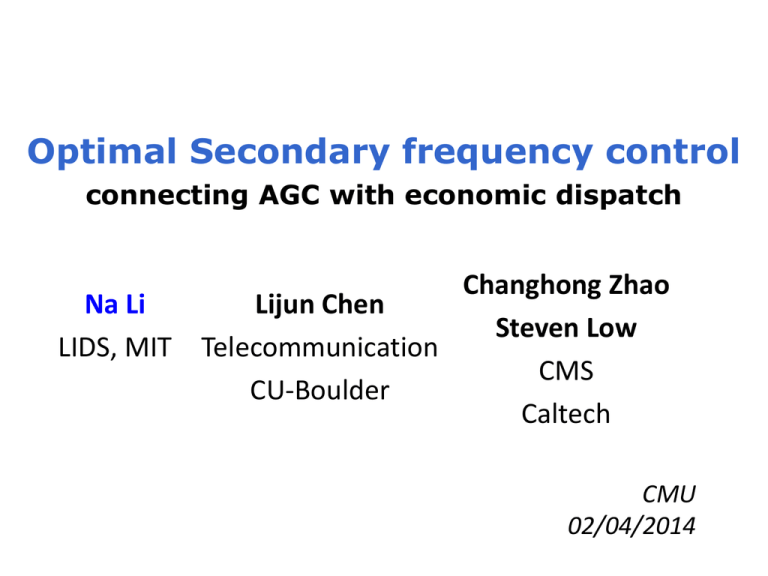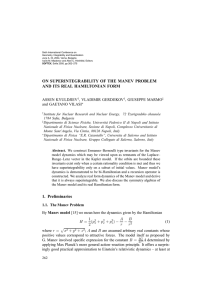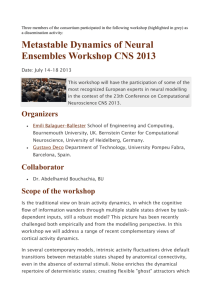Optimal Secondary frequency control Na Li LIDS, MIT
advertisement

Optimal Secondary frequency control connecting AGC with economic dispatch Changhong Zhao Na Li Lijun Chen Steven Low LIDS, MIT Telecommunication CMS CU-Boulder Caltech CMU 02/04/2014 Frequency control economic dispatch unit commitment secondary freq control primary freq control sec min dynamic model e.g. swing eqtn 5 min 60 min day power flow model e.g. DC/AC power flow year Frequency control economic dispatch secondary freq control Optimally schedule gens/loads, and the inter-area power flows Maintain the nominal freq and the inter-area power flows ∆ Total Gen = ∆Total Load sec min dynamic model e.g. swing eqtn 5 min power flow model e.g. DC/AC power flow Area 1 Area 2 Area 3 Inter-area power flows Frequency control To Improve secondary freq control sec 1. Optimally schedule gens/loads within a area economic dispatch min dynamic model e.g. swing eqtn Maintain the nominal freq and the inter-area power flows 2. Optimally (re)schedule gens/loads among it is permitted) ∆ Total areas Gen =(if ∆Total Load 5 min power flow model e.g. DC/AC power flow Area 1 Area 2 Area 3 Inter-area power flows Frequency control To Improve 1. Optimally schedule gens/loads within a area economic dispatch secondary freq control Maintain the nominal freq and the inter-area power flows 2. Optimally (re)schedule gens/loads among areas (if it is permitted) sec min dynamic model e.g. swing eqtn 5 min power flow model e.g. DC/AC power flow Motivation: Power system efficiency Frequency control To Improve 1. Optimally schedule gens/loads within a area economic dispatch secondary freq control Maintain the nominal freq and the inter-area power flows 2. Optimally (re)schedule gens/loads among areas (if it is permitted) sec min dynamic model e.g. swing eqtn 5 min power flow model e.g. DC/AC power flow Challenge: Physical dynamics + existing control mechanisms (AGC) Physical dynamics: Swing Dynamics - Swing + ωi : Mechanical power : Load ωi : Frequency Pij : Power Flow Mi, Di: Constant parameters Bus i: control area/ balance authority + - Swing ωj Variables: the deviations from reference (steady state) values Power Flow dynamics - Swing + - Pij Flow ωi + - -1 + - Swing ωj : Mechanical power : Load ωi : Frequency Pij : Power Flow Tij: Constant parameter Assumptions: Lossless (resistance=0) Fixed voltage magnitudes Small deviation of angles Turbine-Governor Control + 1/R1 - Governor - Swing + - Pij Flow ωi + - -1 + 1/R2 Governor + - Swing ωj : Mechanical power : Load ωi : Frequency Pij : Power Flow : Power command input Ti, Ri: Constant parameters (Area Control Error) ACE-based AGC B1 + + 1/R1 + ACE Governor - Swing + - Pij -1 + + B2 Flow ωi + - -1 ACE + - 1/R2 Governor + - Swing ωj : Mechanical power : Load ωi : Frequency Pij : Power Flow : Power command input Ki, Bi: Constant parameters Recap: System Dynamics with AGC i Pi m Swing dynamics Pij Pi L Power Flow Dynamics Turbine-Governor Control ACE-based AGC Suppose the system is in steady state (all variables = 0) Disturbance, e.g. Pi L Drive the system to a new steady state (i) Economically Dispatch (ii) Our objective to minimize generation cost j Recap: System Dynamics with AGC i Pi m Swing dynamics Pij Pi L Power Flow Dynamics Turbine-Governor Control ACE-based AGC Suppose the system is in steady state (all variables = 0) Disturbance, e.g. Pi L Drive the system to a new steady state (i) (ii) Generation cost Power flow balance Economic AGC j Recap: System Dynamics with AGC i Pi m Swing dynamics Pij Pi L Power Flow Dynamics Turbine-Governor Control ACE-based AGC Question: How to modify AGC to be economic AGC? Drive the system to a new steady state (i) (ii) Economic AGC j Results: Economic AGC i Pi m Swing dynamics Pij Pi L Power Flow Dynamics Drive the system to a new steady state (i) (ii) Economic AGC j Results: Economic AGC i Pi m Swing dynamics Power Flow Dynamics Theorem(Li, Chen, Zhao, Low 2013): Any trajectory P M (t ), (t ), P(t ) converges to P M * , * , P* • P M * is optimal to economic dispatch * • 0 • P* is a feasible power flow Pij Pi L j Results: Economic AGC i Pi m Swing dynamics Pij Pi L Power Flow Dynamics Local computation Local communication — Additional local variable — Frequency, Power flow, Power Command: local measurable signals — A decentralized algorithm; Local information and communications — Not just local… j Not Just Local… i Pi m Swing dynamics Pij Pi L Power Flow Dynamics Only use information/signals that are easy to measure or calculate j Extension to load freq control i Pi m Swing dynamics Power Flow Dynamics Drive the system to a new steady state (i) (ii) Load disutility Pij Pi L Similar mechanisms apply to load control Optimal gens/loads control j Tool: reverse/forward engineering System Dynamics & Existing Control Economic Generation Control (i) (ii) Analogy ? solve Optimization Problem Reverse Tool: reverse/forward engineering System Dynamics & Existing Control Economic Generation Control (i) (ii) Modified Optimization Problem Equivalent Forward Tool: reverse/forward engineering System Dynamics & Modified Control Economic Generation Control (i) (ii) solve Modified Optimization Problem Equivalent Forward Case Study 1 2 4 control areas: a 39-bus New England Transmission Network Source: Ilic, et.al. IEEE TPS, vol. 8, no. 1, 1993 4 • • • • 3 At time t = 10s, load increase 0.2 pu at area 4 (Nonlinear) power flow model; Nonzero resistance Sample rate =15s (e.g., ACE is reset for every 15s) Each area has a same cost function (optimal value should be that each area increase generation by 0.05 pu ) Mechanical Power, PM (pu) Mechanical Power Generation 0.3 0.2 Area 1 Area 2 Area 3 Area 4 0.1 0 -0.1 0 0.3 Mechanical Power, PM(pu) ACE-based AGC 100 200 300 400 600 Area 1 Area 2 Area 3 Area 4 Economic AGC 0.2 500 0.1 0 -0.1 0 100 200 300 Time (s) 400 500 600 Total generation cost 1.4 Generation cost 1.2 1 ACE-based AGC 0.8 0.6 Economic AGC 0.4 0.2 Optimal value of economic dispatch 0 0 100 200 300 Time (s) 400 500 600 Frequency Frequency (Hz) 60.01 60.005 ACE-based AGC 60 Area 1 Area 2 Area 3 Area 4 59.995 59.99 59.985 Frequency (Hz) 0 60.01 100 200 300 60.005 400 500 600 Economic AGC 60 Area 1 Area 2 Area 3 Area 4 59.995 59.99 59.985 0 100 200 300 Time (s) 400 500 600 Conclusion economic dispatch secondary freq control primary freq control 1. Optimally schedule gens/loads within a area Maintain the nominal frequency and the inter-area power flows 2. Optimally (re)schedule gens/loads among areas (if it is permitted) Minor Modification (additional local computation and communication based on local measurable signals) Back Up System dynamics Economic Energy Control c (P ) m min i i i over Pi m , s. t. Pi m = Pi L i 0 Partial primal-dual gradient algorithm min Reverse Engineering over s. t. 1 2 ( Pi m )2 D2i i 2 i Pi M , Pi M = Pi L Dii Pi M = Pi L P P j:i j ij k :k i ki P P j:i j ij k :k i ki Economic AGC Economic Energy Control c (P ) m min i i i over Pi m , s. t. Pi m = Pi L P P j:i j ij k :k i i 0 Forward Engineering Partial primal-dual gradient algorithm min 1 2 ( Pi m )2 D2i i 2 Pi M , s. t. Pi M = Pi L Dii Pi M = Pi L i i over ci ( Pi m ) D2i i 2 P P j:i j ij k :k i Pi M Pi L ki j:i j ij k :k i ki ki

